July 13, 2020
How to avoid injury after a pandemic

Dr. Nicholas Mohtadi, MD, is worried about what COVID-19 could do to our bones and joints. Mohtadi, an orthopedic surgeon, member of the McCaig Institute for Bone and Joint Health and medical director of UCalgary’s Sport Medicine Centre, isn’t so worried about our musculoskeletal health during the pandemic. It’s what could happen afterward that has him concerned.
“During this pandemic, our normal activity levels have changed. Many have adapted well, by walking, running, creating home gyms and doing virtual exercise programs. Some are even more active than before. But many have seen their fitness decline,” says Mohtadi.
As we get back to “normal” there will be the inevitable resurgence in activity levels, and Mohtadi predicts we will be faced with three unavoidable certainties when it comes to our musculoskeletal health.
What happens when fitness levels decline?
The first certainty has to do with the second law of thermodynamics — entropy. Entropy is the “process of degradation or running down, or a trend to disorder.” In the context of the musculoskeletal system it refers to bones, ligaments, muscles, and tendons degrading over time, primarily due to the natural aging process.
"It is a given that disordered or degraded tissues will be more susceptible to injury," says Mohtadi.
The second certainty, according to Mohtadi, relates to the biomechanical properties of our musculoskeletal tissues which need mechanical stimuli, in the form of movement and/or mechanical loading, to maintain or build strength. A reduction in our normal daily loading will result in tissues that are weaker and less resilient, says Mohtadi.
The third certainty relates to our understanding of musculoskeletal injuries, says Mohtadi. There are primarily two types of bone and joint injury — acute traumatic injury and overuse injury. Research shows that a person who has sustained an acute injury, for instance an ankle sprain, is at greater risk of suffering a repeat injury or a related injury.
Of greater concern to Mohtadi in the context of the current pandemic, are overuse injuries. The main cause of an overuse injury is change, usually involving an increase in the intensity, volume, or type of activity.
Weakness and injuries
Bed rest used to be the go-to treatment for many medical conditions. “Immobilization was the cornerstone of managing musculoskeletal injuries until practitioners of sport and exercise medicine realized that it was a really bad thing to do,” says Mohtadi. “Entropy takes over and biological stimulation is significantly reduced.”
With people staying home more and moving less, he worries that once people begin to resume their pre-COVID-19 activities, there will be an alarming increase in injuries. "We have been creating a perfect storm of overuse injuries by enforcing rest on the population," he says.
“Our activities will change, as will the intensity of how we do them and likely the volume of whatever we do. In other words, we can predict an epidemic of musculoskeletal injuries.”
Prescription to return to our sports and activities
With restrictions beginning to ease, Mohtadi says we can prevent the predictable epidemic of musculoskeletal injury. “We need to return to our sports and activities gradually and prescriptively. Start out with less intensity and volume. Only change one of these factors at a time. Give yourself the opportunity to recover before moving ahead. For seniors, consider some form of cardiovascular exercise such as walking, some form of strengthening exercise, maintain flexibility and work on balance and control.”
One final prediction: “As competitive sport returns to our lives, the individuals and teams that avoid injury will be most likely to win.”
Nick Mohtadi is an orthopedic surgeon, adjunct professor in the Faculty of Kinesiology, clinical professor in the Department of Surgery, Cumming School of Medicine, member of the McCaig Institute for Bone and Joint Health, and Sport Injury Prevention and Research Centre (SIPRC), and medical director Sport Medicine Centre at the University of Calgary and Lifetime Member Award recipient from the Canadian Academy of Sport and Exercise Medicine (CASEM).

Mohtadi urges caution when returning to pre-COVID-19 exercise
stock image
UCalgary resources on COVID-19
For the most up-to-date information about the University of Calgary's response to the spread of COVID-19, visit the UCalgary COVID-19 Response website.





